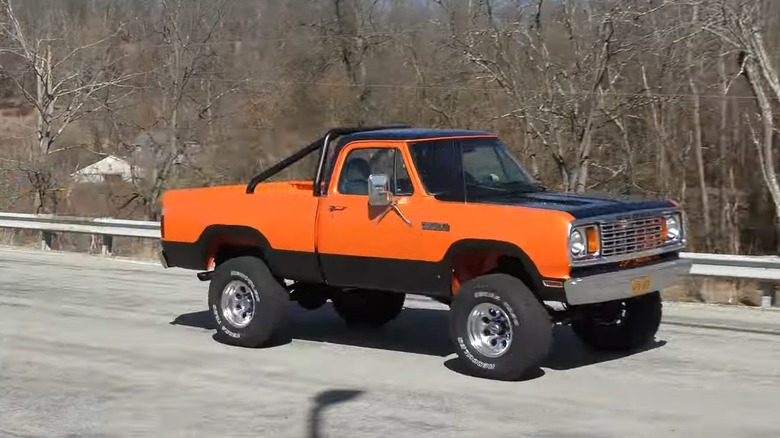All About The Dodge Macho Power Wagon
The year was 1977. Jimmy Carter was the U.S. president, bell bottoms were all the rage, and the original "Star Wars" was capturing hearts and minds for the very first time. In the midst of this disco-fueled year of excitement, Dodge released one of its strangest and most controversial vehicles of all time: The Dodge Macho Power Wagon.
Based on the wildly popular and iconic Power Wagon, the Macho Power Wagon was a special edition pickup truck designed as part of Dodge's Adult Toy line. The pickup featured vibrant paint jobs — usually a vivid red or orange with black stripes — typical of the outlandish '70s style and a slew of off-road utility features, including a built-in roll bar, brightly painted wheels, and beefy off-road tires. Though Dodge only produced the Macho Power Wagon between 1977 and 1981, the truck has developed something of a cult reputation, and it has carved itself a spot in the history of strange and unique cars.
Today, the Macho Power Wagon is a rare but prized vintage vehicle. And while many fans devote themselves to restoring these outrageous pickups for shows or personal collections, others continue to use the trucks for what they were always meant to do — work and play.
The Dodge Macho Power Wagon: a product of its time
Dodge's release of the special edition Macho Power Wagon played into the reigning ideas of sexuality and self-expression of the 1970s. The truck appealed to the uninhibited, flamboyant '70s style while marketing itself as a traditionally masculine vehicle for macho men — many advertisements for the Macho Power Wagon even featured attractive blonde women riding shotgun or even standing in the bed.
Beginning in 1977 and ending just a few years later in 1981, Dodge produced the Macho Power Wagon as a special Adult Toy version of its popular and utilitarian W150 pickup truck. All Macho Power Wagons featured eight special edition paint jobs, with the most common options being bright red or orange with a black stripe running along the bottom of the truck's body. The pickups came stock with factory roll bars mounted behind the cabin, as well as a custom black-accented interior with special bench seats and a four-spoke sport steering wheel. Each Macho Power Wagon featured beefy 10-15 LT-B tires mounted on chrome or bright yellow special edition wheels.
The trucks were available with either a 318 cid V8 or a powerful and legendary 440 big block V8. Power steering was standard while locking front hubs meant drivers could switch between 4- and 2-wheel-drive depending on their needs. In addition to choosing between various color schemes, drivers had the option to purchase their Macho Power Wagon with either a 115- or 131-in wheelbase.
The 2016 Macho Power Wagon
Dodge discontinued the Macho Power Wagon in 1981, and the company would go on to rebrand its pickup trucks as Power Rams or simply Rams, dropping both the macho name and the outlandish paint jobs. But though Dodge retired the Macho Power Wagon moniker, its legacy lived on. And in 2016, Dodge unveiled a modernized version of the Macho Power Wagon as a concept vehicle.
Featuring a vivid orange paint job that Dodge refers to as Macho Mango, the 2016 Macho Power Wagon concept truck is somehow both anachronistic and futuristic. The concept truck was built using the 2016 2500 Ram Power Wagon platform and shares the same motor: a 6.4L HEMI capable of producing 410 horsepower. It includes a worthwhile cold air intake, 37-inch offroad tires with beadlock wheels, differential lockers, a powerful, high-quality tow winch, and built-in tow hooks. Additional features include imposing fender flares, an aggressive front bumper, and a large "sail" in the bed that functions as an extended cargo rack. The truck's interior is just as eye-catching as its exterior and features matte-black fabric and accessories with bright Macho Mango accents.
While it was never released to the public, the 2016 Macho Power Wagon concept truck paints an intriguing picture of how a modern version of the iconic '70s pickup might look. Its attractive design and impressive features appeal to truck lovers and gearheads, while its name makes us question whether some things are better left in the past.


